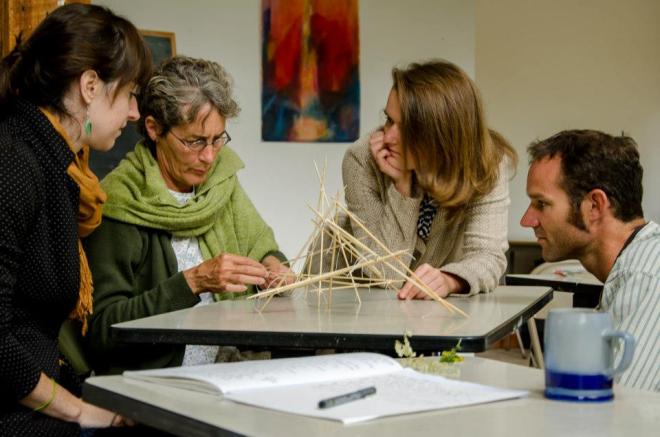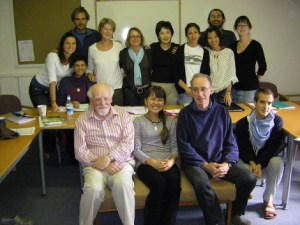If we talk of deadly, let us note that the difference between life and death, so crystal clear in man, is somewhat veiled in other fields.
A doctor can tell at once between the trace of life and the useless bag of bones that life has left; but we are less practised in observing how an idea, an attitude or a form can pass from the lively to the moribund.
It is difficult to define but a child can smell it out.
Peter Brook, The Empty Space
In the early summer of 2012 I came across a short course that felt like it had been tailor made, just for me! Considering my passion for phenomenology and commitment to researching the act of getting to know the world in terms of itself, it simply could not have been more perfect. So, in September 2012 I attended this week-long course in the US with Craig and Henrike Holdrege, entitled “A Pathway to Living Knowledge”. The course was co-sponsored by Threefold Educational Center and The Nature Institute.

Craig Holdrege
I was taught by Craig Holdrege on the MSc in Holistic Science at Schumacher College in 2008. He attended our week long session with Henri Bortoft, and then carried on the phenomenological work by spending a week with us on practicing and exploring Goethean Science. Craig is the director of the The Nature Institute which he co-founded 1998. “His passion is to develop what Goethe called “delicate empiricism” – an approach that learns from nature how to understand nature and is infused with a cautious and critical awareness of how intentions and habits of mind affect human understanding. His research takes two directions. In the first, he carries out studies of animals and plants that tell the story of these organisms as dynamic and integrated beings within the larger web of life. The comprehensive and holistic understanding of organisms provides the basis for his second area of focus – researching genetics and genetic engineering in relation to the broader context of internal and external ecology of living organisms. Craig has a Ph.D. in sustainability education from Prescott College in Arizona. He completed a Masters-level, non-degree program in phenomenological science at the Science Research Laboratory at the Goetheanum, Switzerland, and has a B.A. in philosophy from Beloit College.”1

Henrike Holdrege
On this short course in the US, I also had the pleasure of meeting Craig’s wife, who co-taught alongside him. “Henrike Holdrege is a co-founder of The Nature Institute. She is a mathematician and biologist, subjects she taught in public and Waldorf schools. At the Institute Henrike is involved in all aspects of the Institute’s life. She carries out research in projective geometry and into the phenomena of light and color. She helps with program conception and implementation and teaches courses in our education programs. She is the Institute’s finance manager, keeps the place beautiful, and basically steps in wherever help is needed.
Henrike teaches courses in projective geometry at the Institute as well as around the country. She is interested in leading people – especially those who “never liked math” – into unfamiliar thought territory. In projective geometry we have to let go of common thought habits in order to stretch our inner terrain. We discover thereby our ability to conceive of the invisible and enliven our thinking capacities. We build new “thought muscles” and gain insights that we can apply in everyday and professional life. In her work with the phenomenology of the visual world, she wants to help people become more attentive to the actual visual appearances and their relations; this activity opens up a deep appreciation for the qualities of light and color and is also a means of overcoming abstract habits of thought.”2
It was truly a pleasure to work with both Craig and Henrike for a whole week. Craig is as fundamental to the development of my passion and interest in practicing phenomenology as Henri Bortoft is. Together they both contributed to a way of seeing that grew in me that enables me to ‘see’ the dynamics of life, and this profoundly alters my ways of being, seeing and doing in the world, which I am profoundly grateful for. So it was great to be able to re-visit processes, practices and ideas together with Craig and Henrike, within the beautiful setting of early fall in Chestnut Ridge, New York state last fall.

Photo credit: Threefold Educational Center
The course focused on the nature of phenomenological inquiry, with its roots in Goethe’s approach. In essence, the question was: How can we develop capacities that allow the qualities and relationships inherent in the world to come to ever greater expression? As Steiner wrote, “to live in truth means, in the consideration of any given thing, that we attend to the inner experience that arises as we behold it.” The course was set to question how can we heighten that experience and observe, as Goethe asks, “who speaks here, the object or you?” Another question posed was, can we enhance our capacities and cultivate inner organs of perception? And so we set out to enter a pathway of experience and to practice phenomenological methodology in the exploration of natural phenomena.
Prior to the course I also attended a conference at the same Chestnut Ridge venue on ‘The Art and Science of Wholeness’, for which Craig was the keynote speaker. So my journey back into the dynamics of being started there. During his keynote speech Craig started by noting the importance of looking at the types of questions we use when we are working towards developing a living inquiry, and that we must become aware of the implications and assumptions held within the context and content of a question e.g. “What causes the disease?”. A question is just the tip of an iceberg of a worldview and way of being in the world. The act of questioning is in itself a part of something much larger than itself. Questioning is, in it’s nature, a relational, dynamic act of inquiry. It is an expression of already having met something, of having related with something. The expression of experience in questioning expresses both the knowing and unknowingness of something that has been touched, that we are then moved by. The consciousness of the phenomenon comes to movement through the questioning process. If the questions are open, arising out of having been touched by something in the world, they can form the seeds of a living inquiry.

Photo credit: Threefold Educational Center
Questions that go where awe and wonder arise, that emerge from an experience meeting the worlds mysterious depths, like a sunset, the night sky or the sea’s waves, create the container for a living inquiry to be born. The fundamental question that Craig put to us was ‘As educators, how can we help an encounter to arise from within the students that involves them and the world, rather than just answering questions that they themselves have not asked?’ This, for me, is the key to developing A Pathway to Living Knowledge, and is at the centre of the experiential workshops that I have since developed.
Craig, reflecting the essence of Goethe’s work with natural phenomena and also the work of Henri Bortoft, stated during the keynote that he feels that a living inquiry is a path of inquiry in which the world is an active participant, where you have respect for the encounter and a gentle, honest intention of getting to know it’s authentic self. We need to allow the world to speak in terms of itself. The living inquiry can also be called an open ended conversation. The open-endedness naturally arises when we sense the depth of the world, and of our inquiry. As we are in the process of getting to know it, in depth and detail, we can also be open to noticing how the quality of the questions change during the process of the questioning. We engage in a conversation with the part of the world that we felt drawn to turn towards, holding questions only as containers for process, bringing the encounter into consciousness without becoming attached to the questions.
An inquiry becomes dynamic and alive when we begin to understand ‘knowing’ as ‘becoming’, an evolutionary process that is as much an intrinsic and dynamic part of the world, as the world itself, rather than a fixed ‘knowledge’ that we statically project onto the world as our ‘ideas’ or ‘theories’. Through cultivating our ‘knowing’ as living process we may find a way into the world so that our thoughts and theories may emerge from the world itself.
Craig stressed that we must become aware of how much ‘thought’ influences life, and how many ‘things’ that we base our ideas, theories and unquestioned assumptions on actually turn out to be just ‘thoughts’. This occurs in life, research and especially in the Sciences. Rather than a research hypothesis – which rather assumes that you know what you want to get out of an inquiry in advance – to engage in a living ‘conversation’ with the world, we must openly be interested in getting to know it in terms of itself, not tell it what we think we already know about it and then set about proving it.
To enliven our inquiry we must use all of our available faculties of ‘knowing’, not just sense perception and intellect, but also imagination, intuition. We can bring form and process to movement within our imagination, and ‘see’ connections in the wider context by bringing observations and accounts of form, behaviour, movement, structure to life within our imagination. Intuitive moments may also spontaneously arise that can help to illuminate the wholeness of what we are encountering. The living inquiry must also take into consideration the inquirer, who must also work diligently to continually open and improve their capacity for critical thinking, so as not to fall back onto projecting static thoughts or generalization onto the subject of the inquiry – tending to your inner horizons, not just focusing blindly onto the outer horizon that you ‘think’ you see outside of you.
Following Goethe, I feel that this involves developing a dynamic, living way of seeing that itself may be fluid enough to follow the movement of the life of the phenomenon that you wish to get to know. This must be created to understand form as echoes of movement, which are often at first silent if they not visible to the sense world. The wholeness of a phenomenon gestures visibly in time and space, however it is no-thing, but also not a ‘thing’. A living inquiry tries to understand wholeness as an expression of the language of life.
During the week with Craig and Henrike, we did not study an abstract theory, nor be ‘filled like empty vessels’ with information. We were led from day one into our own living inquiries with the world around us.
To be continued in Part Two…
References
(1http://www.threefold.org/conferences/pathway_to_living_knowledge.aspx (2) http://www.threefold.org/conferences/pathway_to_living_knowledge.aspx
About Emma Kidd
Emma Kidd is a researcher, writer, teacher, designer, facilitator, photographer and philosopher. Her work examines how humans can develop a dynamic way of seeing which is cultivated by participative enquiry and a deepening of our relationship to Nature and her dynamic organic systems. She teaches the practice of Phenomenology and offers a series of practical and interactive workshops designed to cultivate integrated ways of knowing within the individual and the organization. Part of her phenomenological work with plants is referenced in Henri Bortoft’s book “Taking Appearance Seriously: The Dynamic Way of Seeing in Goethe and European Thought” and she is a co-author of “Stories of the Great Turning” an inspirational collection of stories from a diverse collection of grass-roots sustainability projects. Her chapter is the story of her upcycling project, Emiliana Underwear (www.emilianaunderwear.wordpress.com) and she is the editor of www.sensinglife.net.









